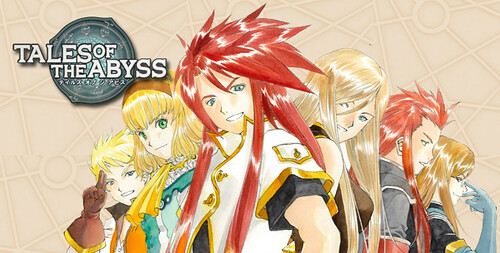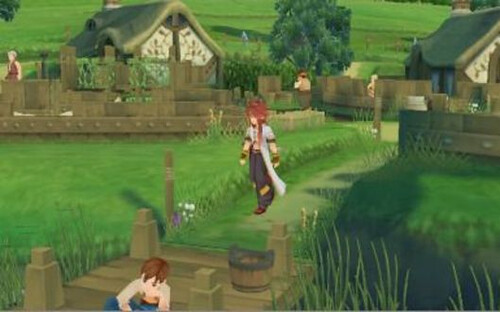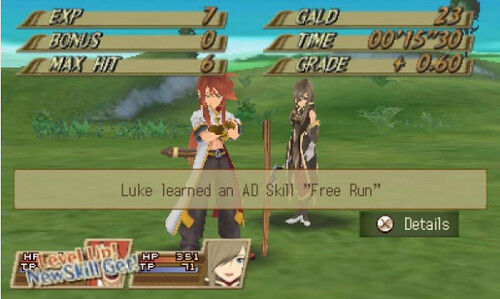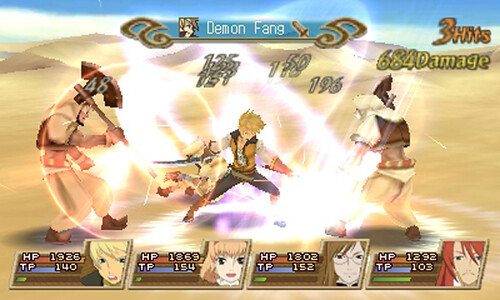|
Disclosure: We may earn a commission from links on this page
|
Developer: Namco Tales Studio | Publisher: Namco Bandai |
| Release Date: February 14, 2012 | Available On: PS2 and 3DS |
Namco Bandai’s Tales of the Abyss for 3DS is essentially a port of a PlayStation 2 game from 2006 by the same name. Though it doesn’t sound like much for “exclusive content”, the port boasts 3D effects with the new handheld as well as dual-screen support, in addition to new artwork designed by Kousuke Fujishima. Now that we have gotten the Wikipedia-style definition of Tales of the Abyss out of the way, I would like to break down exactly what makes this JRPG for the 3DS worth your time and attention. Keep in mind that I’m not normally so generous with my attention span – regardless, this one caught my eye, and pulled me in more than I expected.

Tales of the Abyss takes place in a world called Auldrant, a planet that for ages was known to consist of six major “Fonons” – the most basic elements of life, more or less. Anyway, Auldrant slips into chaos when a seventh Fonon (Sound) is discovered. The various regions of the world basically engage in a holy war for thousands of years, trying to obtain fragments of the special “Fonstones” that are said to reveal a prophecy known simply as the “Score”.
Flash-forward to the present time; a 17-year-old amnesiac brat named Luke is busy being miserable about his life of captivity within the walls of the Fabre family manor, unable to step outside and see the world around him. His pampered life of being served and waited on comes to an abrupt end when a mysterious woman named Tear breaks into the manor and breaks out Luke, essentially thrusting him into a worldwide conflict involving the Fonstones and the Score. This is where the player comes in, and the game really takes off.

Exploring small villages = par for the course in all JRPGs
Interestingly, Luke is not the protagonist you’d expect. His time spent living in the manor has made him selfish, shallow, stubborn, and sheltered to the point of sheer ignorance – he has no idea what life on the other side of the walls is like, and it shows in every single conversation he has with other characters for quite some time. While he isn’t immediately likeable, Luke comes around eventually – and the supporting characters around him are also pretty strong, not to mention there are even cute little critters called cheagles, one of which – Mieu – joins your party and uses a special “Sorcerer’s Ring” to help you out along the way.

The ligers are the cheagles’ natural enemy.
Tales of the Abyss is a pretty standard, traditional JRPG in most regards: you spend a lot of time exploring the world map, stopping in towns and villages along the way as you navigate dangerous dungeons and other environments, filled to the brim with enemies and boss characters. There are also plenty of conversations to read through, with many of the “skits” from previous Tales games making a return appearance in this one as well.
As with all Tales games, battle is done in real-time, with each encounter starting as the player makes contact with an on-screen enemy in the field. The Tales battle system holds up very well on the 3DS, with players using the circle pad to move around the field, attacking with the A button and using special “Artes” with the B button. Combining these buttons with movements on the circle pad results in new attacks and bigger combos, dishing out more damage and so on. The battle system is actually pretty deep, and as you learn new Artes later in the game, each character in the party can be customized and specialized to a great deal.

Learning the “Free Run” skill lets you run around the entire battle area.
As an added bonus, the feeling of playing Tales of the Abyss is not only intuitive, but also “old-school” to the point of being obnoxiously nostalgic. Although Tales of the Abyss originally came out just 6 years ago, it feels like it could be right at home in the 32-bit generation, with its focus on classic JRPG elements like leveling, grinding, managing your inventory, collecting items from fallen foes, and even cooking food by finding recipes across the land.
The result is actually very satisfying; there may be plenty of time spent wandering around between each town and dungeon as you try to find your way, but Tales of the Abyss for the 3DS nonetheless benefits from its ability to provide players with that inexplicably “addicted” feeling that comes with many traditional JRPGs. Even if you burn an hour grinding experience points in the same area against the same foes, Tales of the Abyss is fun to play for the 30-40 hours that it asks of players.

Grinding for hours is fun in Tales of the Abyss.
Moving on, Tales of the Abyss looks absolutely fantastic on the 3DS: the 3D effects and the colorful art style really make the fantasy world of Aludrant come alive more than ever before, with all the lush and detailed environments found in the game. The animated cut-scenes are brilliant, though they don’t seem to use the depth effect quite as well as the graphics in-game. Moving on, the animations in battle are actually pretty smooth, and the frame rate rarely drops, even when you’re dishing out combos and doding a flurry of enemy attacks. The only complaints I have concerning the visuals are the occasional blurry textures, and certain objects within the environment with less detail than others that sometimes stand out like a sore thumb. Finally, the script is almost fully voiced by a talented crew, though some of the voices of the characters come off as being pretty stereotypical (and generally annoying). On the other hand, the music is lovely, from the overworld themes to the battle tracks.
Overall, fans of traditional JRPGs will find a lot to love while playing Tales of the Abyss. It by no means re-writes the book when it comes to the fundamentals, but it doesn’t have to, because it simply delivers them in a way that is accessible, comprehensible, intuitive, and entertaining – that’s all that really matters. Playing Tales of the Abyss reminded me of the time I spent playing Brave Story – an otherwise unspectacular JRPG for the PSP that was memorable solely for its solid gameplay. Again, it’s that inexplicable feeling of being “hooked” to the grinding and the leveling that this game really pulls off well – and I know that’s what all the JRPG fans out there really want these days, among the sea of Western RPGs flooding the market.
| Graphics: | 8.5 |
| Sound: | 8.5 |
| Gameplay: | 8.5 |
| Creativity: | 6.5 |
| Replay Value/Game Length: | 8 |
| Final: | 8.1 out of 10 |
| Written by Cliff Bakehorn | Write a User Review |
